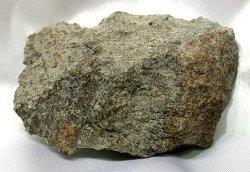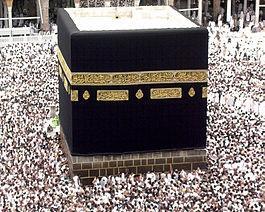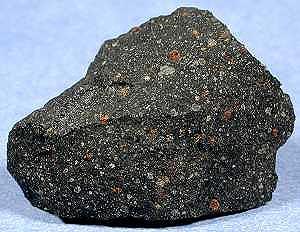Famous Meteorite
Jilin Meteorite
Lucky 13 Meteorite
Kaba Meteorite
Lafayette Meteorite
Lost City Meteorite
The most massive fall of stony meteorites on record; it happened near Jilin in Manchuria, northeastern China (44° 0' N, 126° 0' E) on Mar. 8, 1976. Of the four tons of fragments of the type H5 chondrite recovered, one piece weighed 1.77 tons, produced an impact pit 6 meters deep (only a couple of hundred meters from the nearest house), and is the largest single fragment of stony meteorite ever found.
A carbonaceous chondrite which fell at Kaba, near Debrecen, Hungary, on Apr. 15, 1857. Samples of it and the Cold Bokkeveld meteorite were examined and found to contain organic substances by Friedrich Wöhler, who inferred a biological origin. Ironically, it was Wöhler who had shown that it was possible to make organic chemicals by inorganic means. However, it was only later appreciated that complex carbon molecules can be manufactured in space by purely chemical processes.
The building has a mosque ("Masjid") built around it, the Masjid al-Haram. Muslims are expected to face the Kaaba during prayers, no matter where they are. From any given point in the world, the direction facing the Kaaba is called the Qiblah.
One of the Five Pillars of Islam requires every Muslim to perform the Hajj pilgrimage at least once in his or her lifetime if able to do so. Multiple parts of the Hajj require pilgrims to walk seven times around the Kaaba in a counter-clockwise direction (as viewed from above). This circumambulation, the Tawaf, is also performed by pilgrims during the Umrah (lesser pilgrimage). However, the most dramatic times are during the Hajj, when about 6 million pilgrims gather to circle the building on the same day.
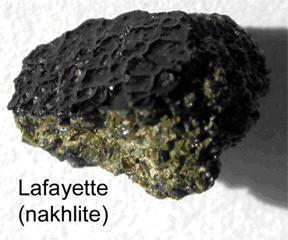
One of the most interesting of the known Mars meteorites. It is named after Lafayette, Indiana, where it was identified as a meteorite in 1931 by O. Farrington having sat for years unrecognized in a Purdue University geological collection. The exact location and date of its fall are not known. However, the Lafayette meteorite is a nakhlite - one of the varieties of SNC meteorite - very similar to the Nakhla meteorite, which fell in Egypt in 1911. In fact, it has been suggested that the Lafayette meteorite may have been mislabeled and be part of the Nakhla fall. It weighs 800 grams (about 2 lb) and is shaped like a truncated cone that measures between four and five centimeters (about 2 in.) across.
Most Mars meteorites show clear signs of having been exposed to moisture and salty water before they were ejected from the martian surface. In the case of the Lafayette specimen, enough weathered minerals are present that it has been possible to put a fairly precise date on when the water exposure took place - 670 million years ago. It contains the most water (0.387%), in the form of hydrated salts, of any martian meteorite.
More interestingly, its composition was enriched in heavy water, as measured when the rock was step-wise heated. The mineral olivine, which generally does not survive unmodified for long when water is present, was also found to be the most altered of all the iron-rich minerals in the sample. When examined in thin sections, the meteor showed rusty-red grains surrounded by black veins, sometimes called a fibrous structure. Taken together, the evidence showed that the Lafayette meteorite had formed initially as an iron-rich, volcanic rock, and had then been exposed to water. Around 700 million years ago some saline began to seep into it, changing its mineral content. About 11 million years ago, the fragment was ejected from Mars as debris from an impact and then landed on Earth about 2,900 years ago. In 2000, scientists concluded that the salts identified in the Lafayette alteration (based mainly on the mineral iddingsite) formed by fractional evaporation of an acid brine on Mars. This result is particularly intriguing in light of evidence gathered by the Mars Exploration Rover Opportunity that sulfur-rich brines once soaked the spacecraft's landing site.
The second meteorite fall to be recorded by a camera network, thus enabling its trajectory and orbit to be determined and a quick recovery of the fragments, which weighed a total of 17 kg. The Lost City meteorite was found upon analysis to be an H5 chondrite.
The now-defunct Prairie Meteorite Network, a system of 16 camera stations in seven Midwestern states run by the Smithsonian Astrophysical Observatory, recorded the Lost City fall on Jan. 3, 1970. The photos enabled scientists to reconstruct the meteorite's orbit and determine that it originated in the main asteroid belt.
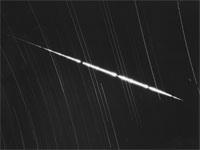
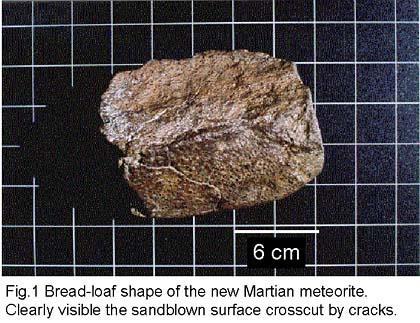
Nickname given, by the British scientists who identified it, to the thirteenth known SNC meteorite. News of its identification was announced on August 12, 1998. The object, about the size of a softball and weighing 2.2 kg (4.8 lb) was found in the Sahara desert. It is important because it appears to have come from a different part of Mars and to be of a different age from the other known SNC meteorites. It is also the only martian meteorite to have a private owner. Six of the others are owned by the US government and six by museums.
A carbonaceous chondrite which exploded into fragments over the town of Murchison, approx. 200 km north of Melbourne in Victoria, Australia, on Sep. 28, 1969. About 82 kg of the meteorite was recovered.
Eyewitnesses arriving at the scene reported smelling something like methanol or pyridine, an early indication that the object might contain organic material. Subsequent analysis by NASA scientists and a group led by Cyril Ponnamperuma revealed the presence of 6 amino acids commonly found in protein and 12 that did not occur in terrestrial life. All of these amino acids appeared in both dextrorotatory (right-handed) and laevorotatory (left-handed) forms, suggesting that they were not the result of Earthly contamination. The meteorite also contained hydrocarbons which appeared
Murchison Meteorite
However, in 1997, John R. Cronin and Sandra Pizzarello of Arizona State University reported finding excesses of left-handed versions of four amino acids ranging from 7 to 9%,1 a result confirmed independently by another group.2 Altogether 92 different amino acids have been identified in Murchison, only 19 of which are found on Earth. To this organic mixture, in 2001, was added a range of polyols - organic substances closely related to sugars such as glucose.3 See also organic matter in meteorites.
[Thanks to Norbert & Heike Kammel, of Rocks on Fire, who pointed out that there are two townships of Murchison in Australia - one about 400 km north of Perth (which this entry originally and erroneously indicated as the site of the meteorite fall), the other in the state of Victoria, where the fall actually took place.]
References
1.Cronin, J. R., and Pizzarello, S. "Enantiomeric Excesses in Meteoritic Amino Acids," Science, 275, 951 (1997).
2.Engel, M. H., and Macko, S. A. "Isotopic Evidence for Extraterrestrial Non-Racemic Amino Acids in the Murchison Meteorite," Nature, 389, 265 (1997).
3.Cooper, G. et al. "Carbonaceous meteorites as a source of sugar-related organic compounds for the early Earth," Nature, 414, 879-883 (2001).



![]()
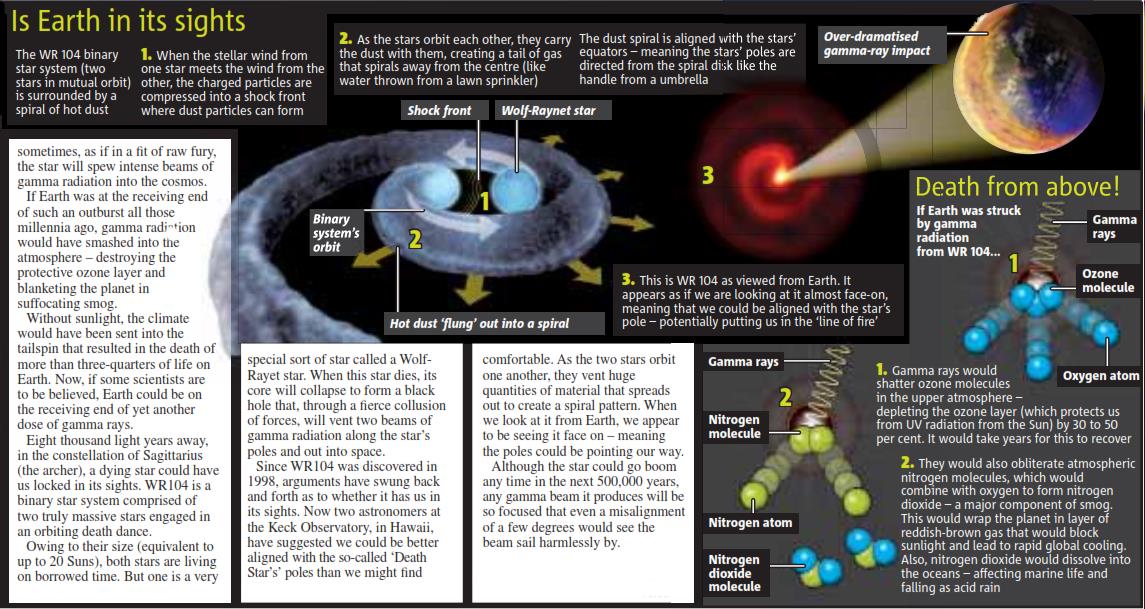
A free template by Lucknowwebs.com for WYSIWYG WebBuilder 8
Meteor-ites
Copyright © by Nigel G Wilcox · All Rights reserved · E-Mail: ngwilcox100@gmail.com
Main Index
Space Cosmology
Designed by Nigel G Wilcox
Science Research
*
About
Science Research
Science Theories
Desk
Site Map
BookShelf
Powered By AM3L1A
Meteor-ites
Pages:
abiogenic in character and was enriched with a heavy isotope of carbon, confirming the extraterrestrial origin of its organics. Initial studies suggested that the amino acids in the Murchison meteorite showed no bias between left- and right-handed forms.
Pages within this section:
1
2
3
Sub-Menu
4
5
Meteor-ites
6
7
8
9


